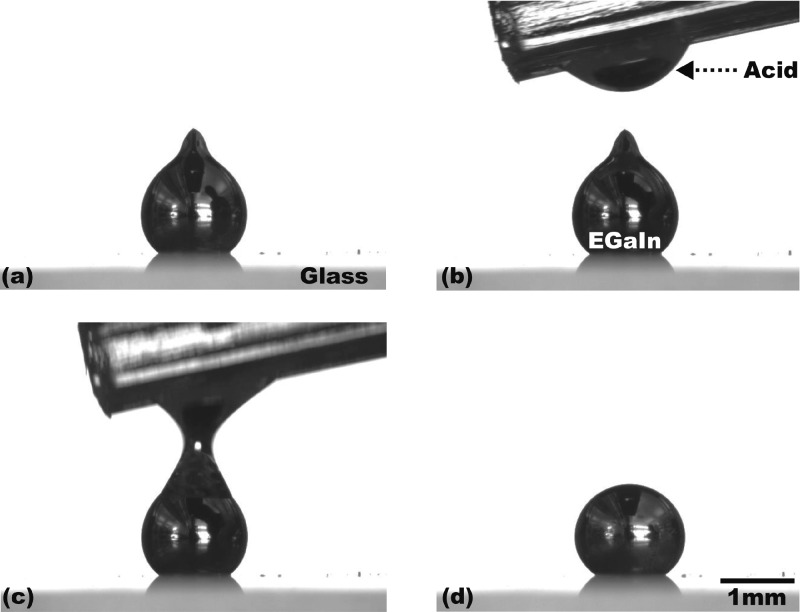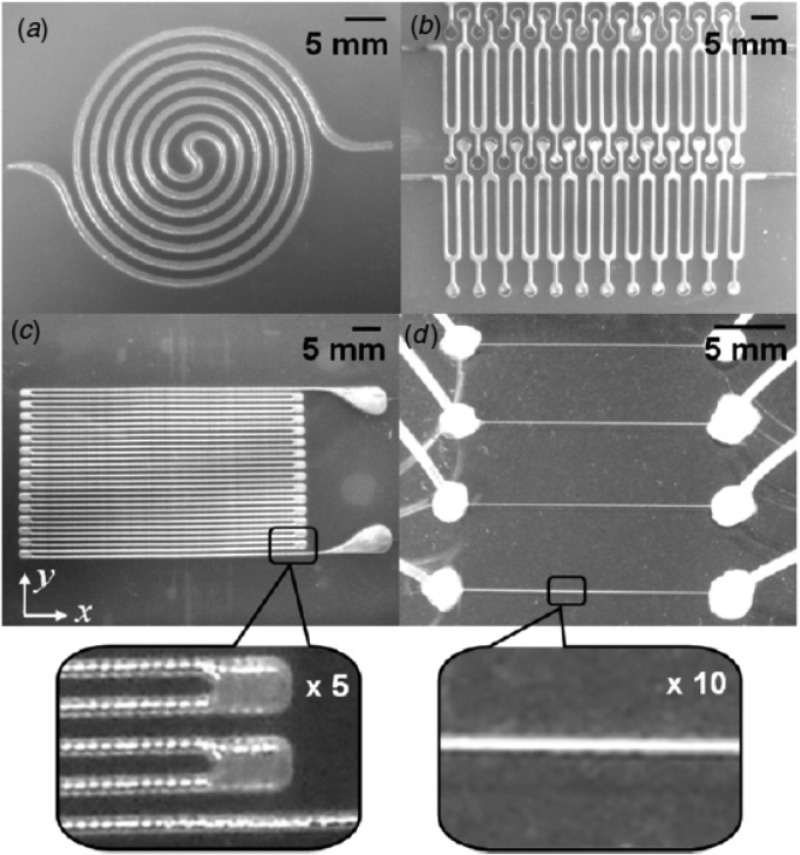Abstract
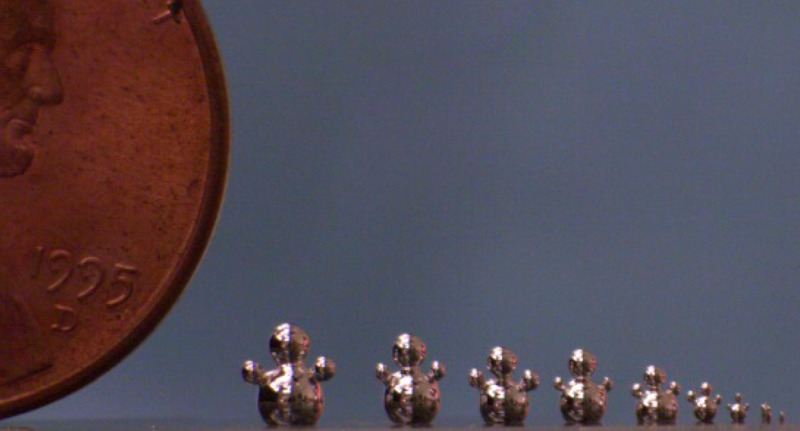
Gallium and several of its alloys are liquid metals at or near room temperature. Gallium has low toxicity, essentially no vapor pressure, and a low viscosity. Despite these desirable properties, applications calling for liquid metal often use toxic mercury because gallium forms a thin oxide layer on its surface. The oxide interferes with electrochemical measurements, alters the physicochemical properties of the surface, and changes the fluid dynamic behavior of the metal in a way that has, until recently, been considered a nuisance. Here, we show that this solid oxide “skin” enables many new applications for liquid metals including soft electrodes and sensors, functional microcomponents for microfluidic devices, self-healing circuits, shape-reconfigurable conductors, and stretchable antennas, wires, and interconnects.
Keywords: gallium, EGaIn, soft electronics, stretchable electronics, liquid metal, gallium oxide
Introduction
The thermal, electrical, mechanical, and optical properties of metals make them an important class of materials for a wide range of applications including communications (antennas), electronics (interconnects, electrodes, heat dissipaters, sensors), and optics (reflectors, metamaterials, plasmonic structures).
Metals that are liquid at or near room temperature are interesting because they are soft and can flow readily in response to stress. There are a number of applications that benefit from metallic components that are deformable, stretchable, injectable, or shape-reconfigurable. Examples include surface-renewable electrodes for polarography, soft sensors, electrical or optical components in microfluidic channels, and conductors in stretchable or reconfigurable electronics. Metals that melt at elevated temperature are also useful for forming metal parts and transferring heat (e.g., in nuclear reactors), but the focus here is on metals that are liquid at or near room temperature.
Most metals are solid at room temperature. Mercury, francium, cesium, gallium, and rubidium are all metals that are liquid below or near room temperature. Francium is radioactive and cesium and rubidium are both explosively reactive, so these materials are typically avoided. By process of elimination, that leaves mercury, gallium, and alloys of these metals for practical applications.
Applications that utilize liquid metals often use mercury (melting point −38.8 °C), despite its toxicity, because the surface of gallium rapidly forms a passivating oxide layer in the presence of oxygen. This oxide layer is often considered a nuisance because it sticks to many surfaces—much like wet paint—which makes gallium difficult to use for fluidic applications.1 The oxide also provides a physical, chemical, and electrical barrier that prevents the metal from making direct contact with its surroundings. In addition, the oxide interferes with electrochemical measurements, which makes gallium difficult to use for electrochemistry.1 As a consequence, mercury has historically been used for applications such as thermometers, barometers, dental amalgams, and as electrodes in voltammetric experiments (i.e., polagraphy). More recently, mercury has been used at the microscale for micropumps, valves, and optical switches.2−5 Mercury has two principal disadvantages: (1) it is toxic—exposure can take place through inhalation of its vapor or adsorption of soluble forms of mercury through the skin—6 and (2) it has a very large surface tension (>400 mN/m), which generally limits it to spherical shapes. Thus, there is motivation to use alternatives to Hg.
Gallium and Alloys of Gallium
Our group and others have been studying gallium and its alloys as a promising class of liquid metals. Although there have been many studies on gallium since its discovery in 1875, the advances highlighted here are distinguished by the importance of the oxide layer that forms on the metal. The properties of Ga and its oxide layer make it a compelling material for a number of new applications:
-
(i)
Gallium has a low bulk viscosity (approximately twice that of water).7
-
(ii)
Gallium has essentially no vapor pressure. It can consequently be handled as a liquid in ultralow vacuum chambers. There is also no danger of inhalation in a laboratory environment or in an application space.
-
(iii)
It has metallic conductivity that is an order of magnitude lower than copper, but orders of magnitude larger than other liquids such as salt water.8 Its conductivity in the liquid state is larger than the solid state.8
-
(iv)
Unlike Hg, it has low toxicity9 and gallium salts have been utilized as magnetic resonance imaging (MRI) contrast agents and in pharmaceuticals,10 although certain complexes of gallium have notable toxicity.11
-
(v)
It expands when frozen by ∼3.2 vol %.12
-
(vi)
It can supercool far below its melting point (mp 30 °C).13,14
-
(vii)
It alloys with many metals and can make electrical contacts to organic materials.15,16
-
(viii)
The surface oxide has mechanical properties that impart the metal with non-Newtonian rheological properties. These properties allow it to be molded into nonequilibrium shapes, which is the basis for many of the applications described in this spotlight.
Like aluminum, gallium rapidly forms a thin oxide layer on its surface when exposed to ambient oxygen.17 This oxide layer is thin (∼0.7 nm according to X-ray diffraction studies done under vacuum conditions18 although it is likely thicker under laboratory conditions19,20) and does not grow significantly thicker over time in dry air in the absence of a driving force or physical perturbation.18,21 It forms on alloys of gallium as long as the concentration of oxygen is greater than ppm22 levels and forms almost instantly in air at ambient conditions.
Importantly, the oxide skin mechanically stabilizes gallium in stable, nonequilibrium shapes.23,24 Normally, a low viscosity liquid with large interfacial tension will bead up to minimize interfacial tension. In contrast, Ga can be molded into nonspherical shapes that are stabilized by the oxide skin, as shown by the cone shape in Figure 1a.
Figure 1.
Gallium and its alloys can be physically manipulated into (a) nonequilibrium shapes due to the presence of an oxide skin on its surface. (b, c) Exposure to acid removes the oxide skin and causes the metal (d) to bead up due to the high surface tension of the bare metal.
In the absence of the skin, the metal beads up (Figure 1d) because of the large surface tension of Ga and its alloys (>500 mN/m).25 The skin is amphoteric and can be removed at pH < 3 or pH > 10, according to the Pourbaix diagram.26
Gallium has a melting point of 30 °C, but can remain as a liquid at room temperature because of its ability to supercool. Various metals (e.g., indium, tin, zinc) alloy with gallium and depress the melting point below room temperature.12,17 Two of the more popular, commercially available alloys are Galinstan (an alloy of Ga, In, Sn) and EGaIn (75 wt % Ga, 25 wt % In). Although Galinstan has a lower melting point, our group has focused on EGaIn (melting point, 15.7 °C) because it is easier to study the behavior of a binary system than a ternary system. Despite the presence of indium, the surface oxide is composed primarily of oxides of gallium.23 As a result, most of the applications described herein can likely be carried out using liquid Ga or any alloy of Ga that forms a surface oxide.
Rheology
The applications described in this spotlight article rely on the ability to manipulate liquid metal into nonequilibrium shapes due to the presence of the oxide. Rheological studies reveal how the metal coated with the oxide responds to stress.23,27−29 It is not the intent of this spotlight to review thoroughly the rheological behavior of the metal, but understanding aspects of the rheology at a basic level helps explain the applications highlighted herein.
Figure 2a is a depiction of one such experiment where an oscillating top plate and a stationary bottom plate sandwich a sample of EGaIn. Because the bulk viscosity of the metal is low, the oxide dominates the mechanical resistance to oscillation of the top plate. Increasing the amplitude of oscillations at constant frequency allows for the extraction of stress–strain relationships of the oxide and thus, the mechanical properties of the oxide. Figure 2b plots the surface elastic modulus versus surface stress. Below a critical yield surface stress (∼0.5–0.6 N/m), the skin is elastic and stable, which is critical for patterning the metal into nonequilibrium shapes. Above the critical yield stress, the skin ruptures and the metal flows readily.
Figure 2.
Oxide skin that forms on alloys of gallium has a yield stress. (a) It can be measured by placing a thin sample (∼1 mm thick) of the metal between a parallel plate rheometer. The oxide spans the periphery between the two plates. (b) Beyond a critical surface yield stress (∼0.5–0.6 N/m), the oxide breaks and the metal flows readily. Below the surface yield stress, the oxide skin is elastic and mechanically stabilizing. Adapted with permission from ref (23). Copyright 2008 Wiley.
Patterning
The applications described in this spotlight article rely critically on the ability to pattern the metal. Perhaps the easiest way to pattern the metal precisely on the sub-mm length scale is to inject it into microfluidic channels. To a first approximation, the pressure required to induce the metal to flow is proportional to the yield stress and inversely proportional to the channel dimension.23 Above this pressure, the metal flows readily due to its low viscosity. Below this pressure, the metal maintains its shape in the microchannel due to the oxide skin, which mechanically stabilizes it. The pressure required to induce flow is modest and can be achieved by hand using a syringe (e.g., injecting into a capillary with a 10 μm diameter requires ∼15 psi of gauge pressure). Figure 3 is a photograph of a microchannel filled with liquid metal.
Figure 3.
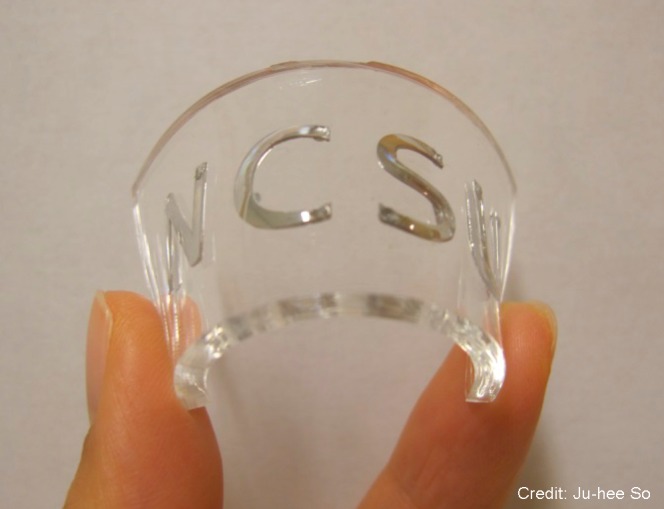
Ju-hee So
Microfluidic channels filled with EGaIn. The metal flows readily into microchannels by injecting it with a syringe, but stays in the microchannels in the absence of pressure because of the formation of the mechanically stabilizing surface oxide. The ability to deform the resulting metallic structures is limited only by the mechanical properties of the encasing polymer.
The oxide allows the metal to be patterned using many conventional techniques such as screen/stencil printing,30−32 contact printing,33 imprinting,34 spray painting,35 coelectrospinning,36 vacuum filling,37 writing with a pen,38 and extruding directly onto surfaces.39,40
Recently, our group showed that it is possible to 3D print EGaIn to form out of plane structures.24 The ability to print liquid metals at room temperature is important because it allows for metallic structures to be printed alongside temperature-sensitive materials such as plastics, organics, and biological materials. The other appeal of liquid metals as printable inks is that it may be possible to directly print soft or stretchable metallic components.
Figure 4 shows images of freestanding liquid metal structures resting on a substrate. These structures may be generated in four different ways: (i) By rapidly applying a burst of pressure to the syringe, a fine fiber of metal (diameters as small as 10 μm) emerges from the syringe, as shown in Figure 4a. These fibers are stabilized against capillary instabilities by the presence of the oxide, as shown in Figure 4b. (ii) By drawing a liquid metal cylinder from a syringe to form wires, as shown in Figure 4c. The process begins by contacting a droplet on the end of a syringe to a substrate. If the droplet sticks to the substrate, increasing the distance between the syringe tip and the substrate generates a tensile force that yields the oxide. Simultaneously applying pressure to the metal keeps the resulting wire from necking (i.e., collapsing) during formation. This same approach may be used for direct-writing the metal in 2D.41 (iii) By stacking droplets on top of each other, as shown in Figure 4d. The droplets form at the tip of a syringe by applying small bursts of pressure inside the syringe to expel the metal. A motorized x-y-z stage positions the droplets, which stick to each other and release from the syringe tip. The presence of the oxide stabilizes these structures and thus prevents them from collapsing into a single bead. (iv) By injecting the metal into microchannels and then dissolving away the microchannels, as shown in Figure 4e.
Figure 4.
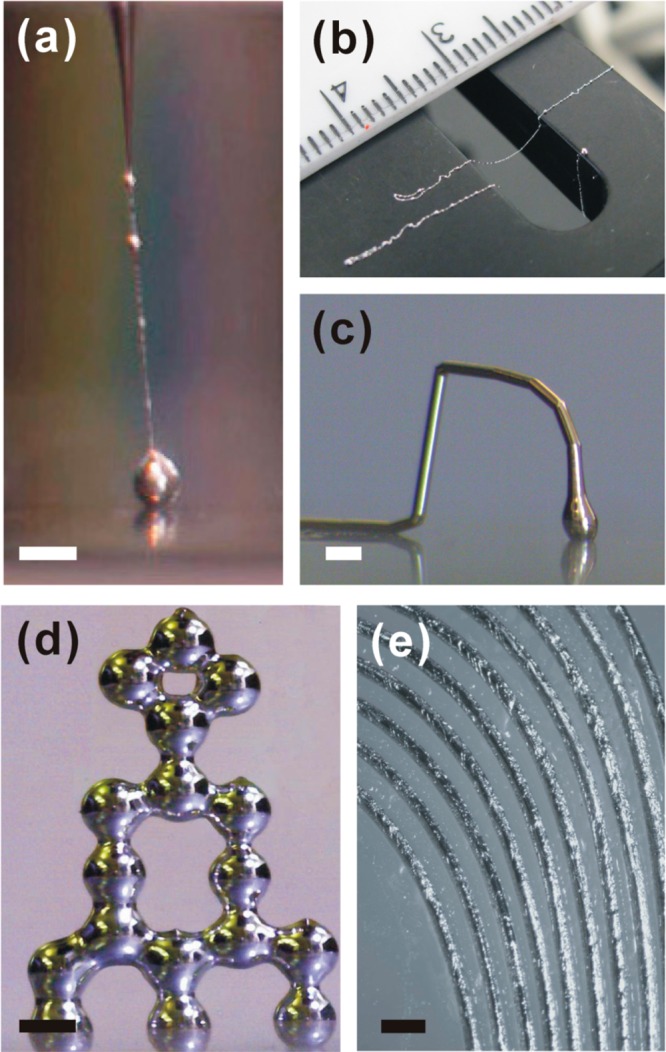
3D printing of free-standing liquid metal structures. (a) Sudden burst of pressure forces liquid metal out of the tip of a syringe, which extends as a fiber to the substrate. The fiber is stabilized by the oxide layer. (b) Resulting fibers are strong enough to span a gap. (c) Extruded wire that is bent into the shape of an arch. (d) Stacks of liquid metal droplets. (e) Liquid metal injected into microchannels remains mechanically stable after dissolving all of the channel walls except the substrate. Scale bars are all 500 μm. Adapted with permission from ref (24). Copyright 2013 Wiley.
Applications
This section describes emerging applications of alloys of gallium enabled by the oxide skin. This section focuses primarily on work done in our group—following the intent of a spotlight article—but references other important work within this context.
Microfluidics
Microfluidics is an interdisciplinary field aimed to manipulate fluids on the sub-mm length scale. The ability to form stable, fluidic metallic structures in microchannels allows for the formation of functional components for microfluidic devices such as electrodes, microheaters, pumps, optical components,42 heat transfer elements,43,44 and antennas.45 Electrodes in microchannels are particularly important for performing electrochemistry, sensing, and for applying electric fields (e.g., for inducing dielectrophoresis, electroosmosis, or electrohydrodynamics).
It is possible to use liquid metals to make metallic components that are inherently aligned with, and in direct contact with, microchannels.46 Usually, metallic microcomponents fabricated by conventional microfabrication must be aligned with the microchannels, which is challenging because of the small length scales involved. The ability to inject the metal into channels makes it possible to form electrodes in a single step without the need for alignment. The electrodes can be brought into direct contact with the fluid of interest by using posts to separate the metal from the fluid. The oxide spans the posts, prevents the metal from flowing into the main channel, and stabilizes the electrodes mechanically. Figure 5 shows an example of these electrodes in microchannels. This strategy has been utilized for several applications including coulter counting,47 valving,48 electrohydrodynamic mixing,46 stimulating neurons,49 and pumping.50
Figure 5.
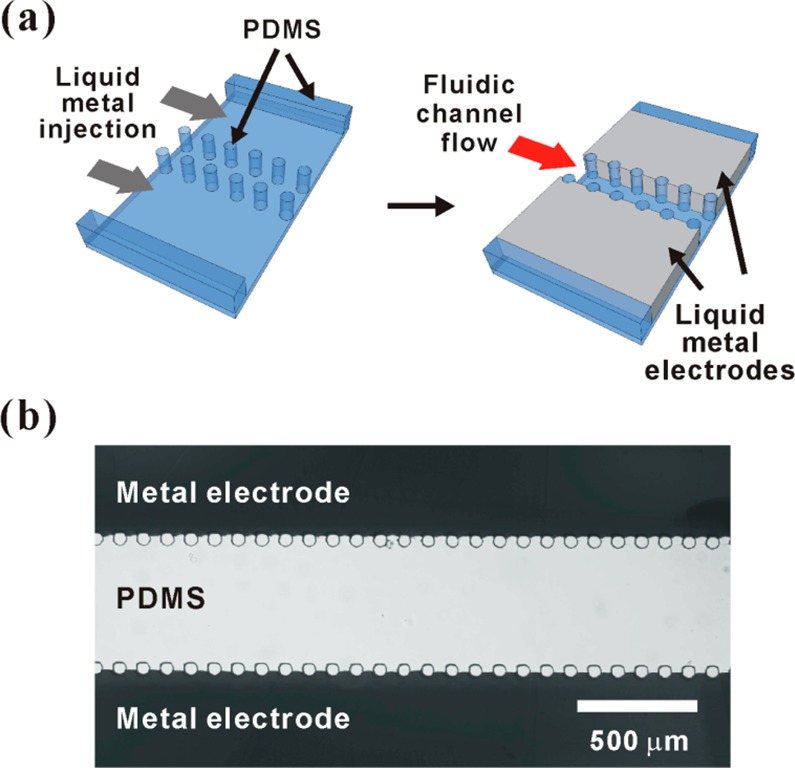
Inherently aligned liquid metal electrodes in microchannels. (a) Cut-away depiction of the process used to fabricate liquid metal microelectrodes in contact with a central fluidic channel. Two parallel rows of posts separate the liquid metal electrodes from the fluidic channel. (Not shown: The channels are sealed on top by a flat slab of PDMS.) (b) Top-down, backlit optical micrograph of the fluidic channel flanked by two liquid metal electrodes. The posts prevent the metal from entering the fluidic channel. Adapted with permission from ref (46). Copyright 2011 The Royal Society of Chemistry.
Our group,51 and others,52 have shown it is possible to use microfluidic flow focusing—the coflow of two immiscible fluids through an orifice in a microchannel—to form liquid metal microdroplets. The use of a continuous phase that sheaths the metal prevents it from sticking to the channel walls. These colloids can form into stable oblong shapes because of the oxide, can be collected, and can be recovered completely into a single sphere of metal by exposure to acid, which removes the stabilizing oxide skin from each microdroplet. Figure 6 contains images of a flow-focusing device as well as spherical and oblong shaped particles of liquid metal that may be fabricated using this technique. We found that coating the droplets with a thin layer of polymer (poly(vinyl alcohol)) helped stabilize them from coalescence. Other groups have made stable liquid metal marbles53 by coating the surface with smaller particles, or nanobeads by sonicating the metal in the presence of ligands that bind to the metal.54 Liquid metal beads and droplets may be useful in self-healing composites,55 for energy harvesting,56 for heat transfer,57 as microfluidic pumps,58,59 actuators,60 as switches,5 or as electrodes.61,62
Figure 6.
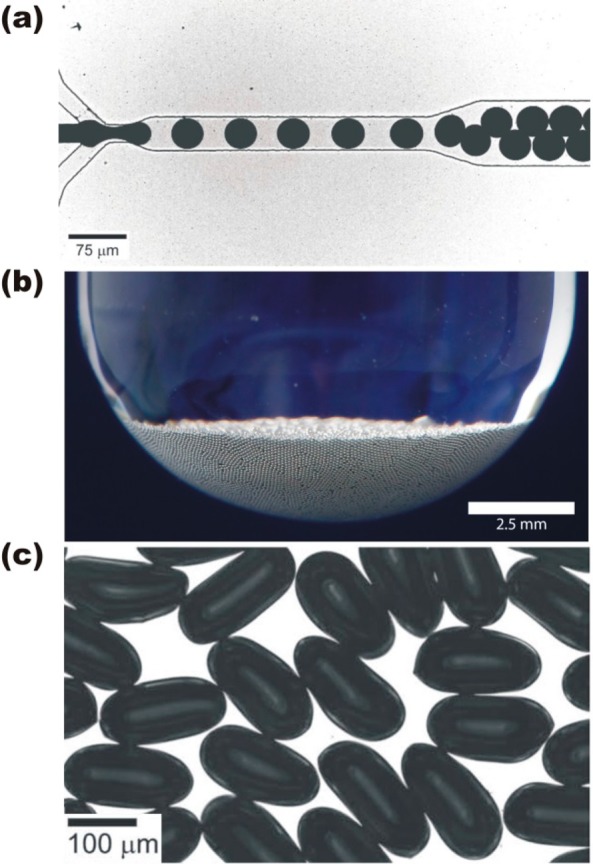
Monodisperse, liquid metal microdroplets formed by microfluidic flow focusing. (a) Liquid metal (dark) is pumped through an orifice along with a continuous phase fluid (clear) in a microchannel to produce droplets. Adapted with permission from ref (52). Copyright 2012 Wiley. (b) Photograph of the droplets. Adapted with permission from ref (51). Copyright 2012 The Royal Society of Chemistry. (c) Micrograph of oblong liquid metal particles formed using microfluidics and stabilized by an oxide. Adapted with permission from ref (52). Copyright 2012 Wiley.
Injecting liquid metal into microchannels also provides a route to form components for stretchable electronics, as described below. This topic has been covered in a recent review.63
Electronics
Metals are useful in electronics as electrodes, interconnects, and antennas. The use of liquid metal allows for the formation of soft, flexible, and stretchable versions of these devices. The combination of these properties may be useful for creating functional components for the emerging fields of stretchable electronics, artificial skins, and soft robotics.64−66
The metal can form soft metallic contacts for gently probing the electrical properties of thin films,15,16 quantum dots,61,67 and self-assembled monolayers.68,69 The thin oxide layer does not interfere with sensitive electrical measurements such as the charge transport through self-assembled monolayers, because these monolayers are typically much more resistive than the oxide.70 Multiple electrical contacts with controlled geometry may be formed by injecting the metal into microchannels placed on the substrates of interest.71 The metal may also be used as stretchable electrodes for solar cells72 and for electroactuation of elastomers.73
Injecting the metal into elastomeric microchannels offers a way to make stretchable versions of electronic components. For example, it is possible to form stretchable interconnects74−77 and sensors.78−82 Our group83 and others84−86 showed that it is possible to form stretchable antennas using the metal. A variety of antennas are possible including patch antennas (useful for GPS),87 phase-shifting coaxial cables,88 coil antennas (useful for wireless power transfer),89 unbalanced loop antennas,84 frequency selective surfaces,90 and plasmonic structures.91,92 Figure 7 shows photographs of several examples of liquid metal antennas. Antennas and resonant structures are a compelling application of liquid metal because their resonant frequency depends on their shape. For example, elongating a dipole antenna via stretching lowers the resonant frequency in a predictable manner; in that sense, the antenna itself is a sensor.
Figure 7.
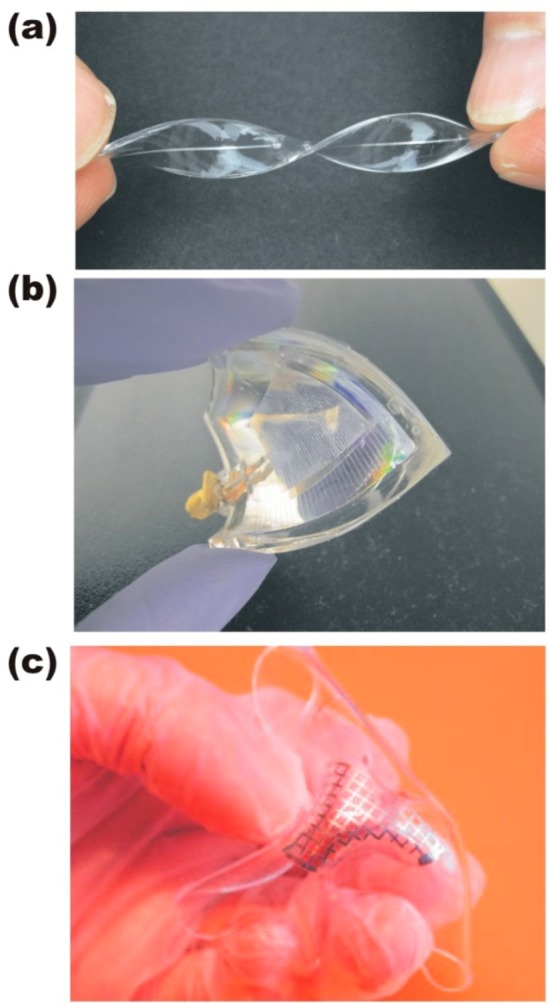
Photographs of flexible, durable, and stretchable antennas formed by injecting liquid metal (EGaIn) into PDMS microfluidic channels. (a) Dipole antenna. Adapted with permission from ref (83). Copyright 2009 Wiley. (b) Micropatch antenna. Adapted with permission from ref (87). Copyright 2012 IEEE. (c) Unbalanced loop antenna from reference. Adapted from ref (84). Copyright 2009 AIP Publishing.
Changing the dimensions of a microchannel via physical deformation changes its electrical resistance, which can be harnessed for sensing.93 Other groups have utilized this principle to make sensor components for detecting deformation, curvature, pressure, and strain for applications including electronic skin and soft robotics.78−81,94−96 Figure 8 contains images of soft sensors of pressure and strain formed by injecting metal into elastomeric microchannels.
Figure 8.
Sheets of silicone rubber embedded with liquid metal can sense pressure or touch because of changes in electrical resistivity resulting from changes in the channel dimensions induced by deformation. (a) Spiral-shaped channels and (b) serpentine-shaped channels for pressure sensing. (c) Strain gauges. (d) Liquid metal structures as small as 25 μm. Adapted with permission from ref (80). Copyright 2010 IOP Publishing.
It is possible to make stand-alone wires by injecting EGaIn into hollow fibers composed of elastomer.97 These fibers are highly stretchable and maintain metallic conductivity up to 700% strain, as shown in Figure 9. Stretchable, conductive composites often consist of solid conductors dispersed in elastomers and therefore undergo a trade-off between their ability to be stretched (favored by low solid content) and conductivity (favored by high solid content). The liquid metal wires disrupt this trade-off because they have the same mechanical properties with and without the liquid metal. The fibers are created in a high throughput manner (thousands of meters per minute) using melt processing. The same stretchable materials can be rendered into 2D microfluidic channels98 and the use of microstructured elastomers can increase the stretchability.77
Figure 9.
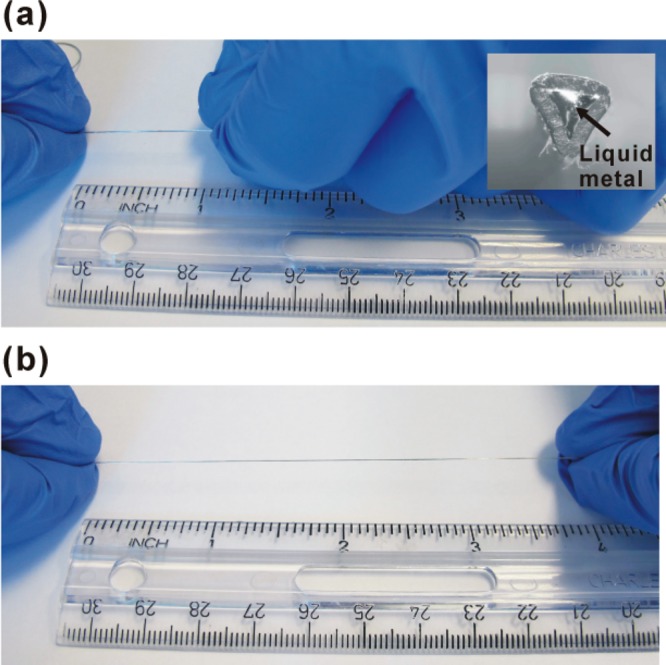
Photographs of ultrastretchable metallic wires formed by injecting EGaIn into the core of a hollow elastomeric fiber. (a) Photograph of a fiber at rest. (b) Fiber maintains metallic electrical conductivity up to ∼700% strain. Adapted with permission from ref (97). Copyright 2013 Wiley.
In the previous examples, the metal is simply serving as a conductive element. The metal can, however, be utilized in a more active way to create soft electronic devices. Combining the metal with hydrogel allows for the creation of memristor (memory-resistor) devices99 and diodes100 composed almost entirely from liquids, since hydrogels are largely composed of water. Figure 10 shows photographs of these devices. These soft devices have the appeal of being matched mechanically to biological systems, built largely from biocompatible materials (hydrogels), operate in an aqueous and ionic environment, and in the case of the memristors, use hysteretic memory; the brain also uses hysteretic memory and memristors are proposed to replicate their behavior. The details behind the operation of these devices are complicated, but may be understood simply as employing interfacial electrochemistry to control the thickness of the oxide. Contacting the hydrogel to the liquid metal allows for electrochemical reactions to occur at the interface. Oxidative bias causes the oxide to thicken (i.e., anodization) and thus become more resistive. Reductive bias causes the oxide to thin and thus become more conductive (between the metal and the gel). Figure 9c shows the changes in conductivity of individual junctions of the device depicted in Figure 9a, b. The memristor assigns the resistive and conductive states as the 1 and 0 necessary for digital memory. The diode works under a similar principle in which the current between the liquid metal and the gel depends on the polarity of the electrode.
Figure 10.
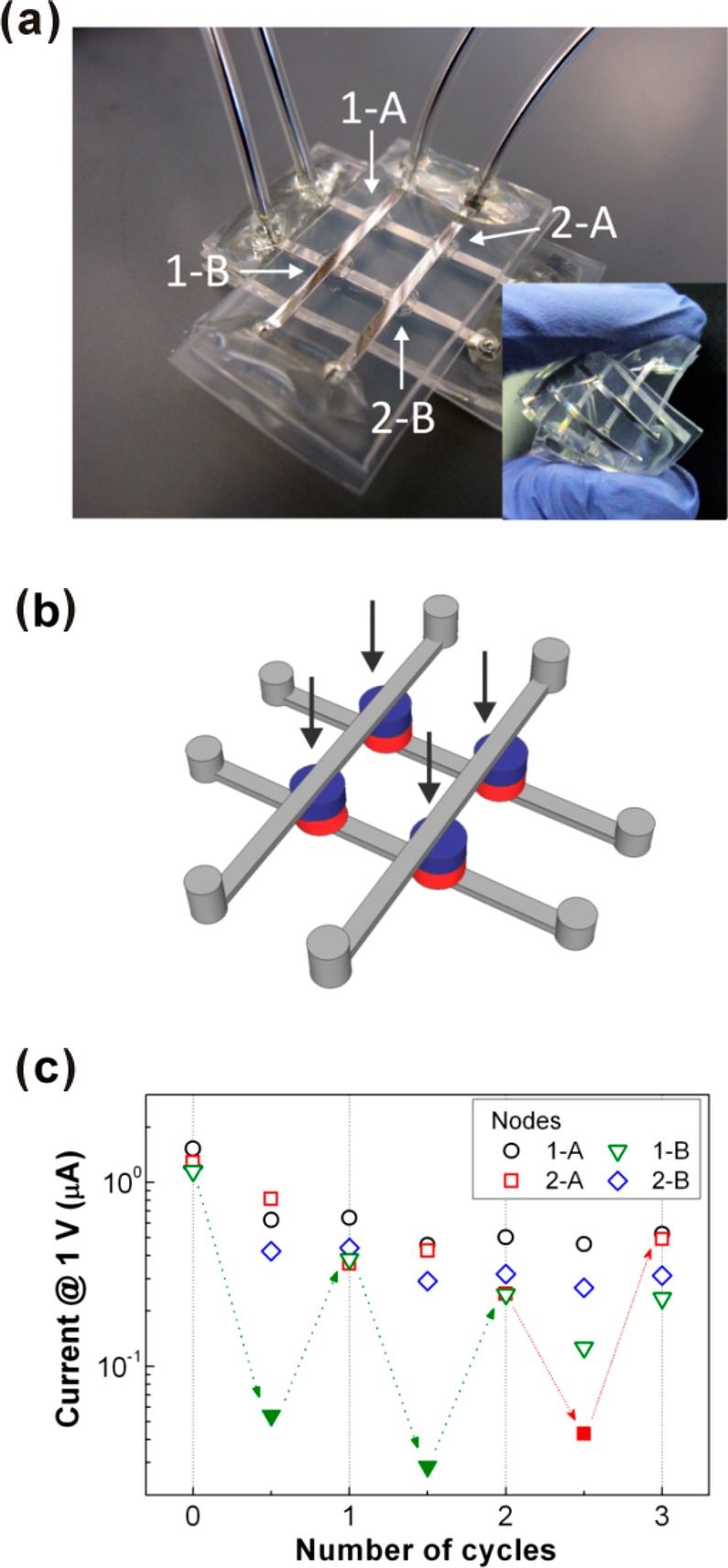
Crossbar array memory device (i.e., memristor) composed of hydrogel and liquid metal. (a) Photograph of a prototype of an integrated soft memristor circuit with a 2 × 2 crossbar array. The device is flexible as shown in the inset image and compatible with water. (b) Schematic of the prototype in a. The arrows point to the nodes, consisting of two different hydrogels sandwiched between liquid metal electrodes. (c) Switching bias to turn “off” (+ 5 V) and “on” (−5 V) the nodes is applied to the 1-B node for the first and second cycles and to the 2-A node for the third cycle, respectively, as shown by the arrows. The filled symbols represent the nodes in the “off” state. Adapted with permission from ref (99). Copyright 2011 Wiley.
Reconfigurable Devices
Because the metal is a liquid, it can change its shape in response to pressure or other stimuli that induce it to flow. We demonstrated shape reconfigurable antennas that change shape, and thus spectral properties, in response to pressure.101 These antennas employ polymeric posts that obstruct flow in the microchannels and control how far the metal flows into the channels. Placing the posts closer together increases the pressure required to flow the metal past the posts. The concept can also be utilized for other electronic structures, such as electronic filters102 and resonant structures.103 Multiple rows of posts allow for multiple lengths to form based on the applied pressure to the metal. Other groups have utilized nonwetting microchannels (e.g., Teflon) or acidic environments to move slugs of the metal to create reconfigurable devices; these approaches, and others, are discussed in the outlook.
Self-Healing
Gallium alloys can form self-healing wires that regain electrical conductivity after being cut. We formed self-healing wires by injecting EGaIn into microchannels composed of self-healing polymer, as shown in Figure 11.104 The resulting wires are stretchable because the polymer is stretchable. When the wires are cut entirely apart by a razor, the rapid formation of the oxide allows the liquid metal to remain stable in the channels and stay flush with the interface generated by the cut. Pressing the severed wire back together physically reunites the metal and regains conductivity while the polymer self-heals via hydrogen bonding.105
Figure 11.
Self-healing wires consisting of EGaIn injected into microchannels composed of self-healing polymer (Reverlink). (a) Schematics illustrating the disconnection and reconnection of a simple electronic circuit using a self-healing wire. A self-healing wire is pictured in the inset. (b) Variation in the resistance of self-healing wires during connection/disconnection/reconnection experiments. (c) Mechanical characterization of a wire before cut (black line) and after self-healing (red squares). Adapted with permission from ref (104), Copyright 2013 Wiley.
It is also possible to make self-healing wires by dispersing liquid metal droplets in polymer placed over conductive traces of gold.55 When cut with a razor, the gold breaks, but liquid metal releases from the polymer matrix, contacts the resulting gap, and alloys with the gold to regain conductivity along the original gold pathway. Gallium alloys also form self-healing electrodes for lithium batteries.106
Optics
Injecting the metal into microchannels forms microscale mirrors that align inherently with other microscale components in the device based on the shape and location of the microchannels.42 Moreover, compressing the channels causes these mirrors to become reflective diffraction gratings. The strain causes the walls of the channel to buckle due to the presence of a thin, rigid silicon oxide layer on the walls and thereby creates periodic structures that have diffractive properties. These microstructures can switch between a diffractive and a spectrally reflective state by applying and relieving applied strain, respectively. The ability to easily form components with these properties may be useful for the field of optofluidics.107 As discussed in the electronics section, liquid metals may also be utilized for RF antennas, frequency selective surfaces, and plasmonic devices.91,92,103
Outlook, Challenges, and Opportunities
The ability to pattern liquid metals into useful shapes has resulted in a number of new applications described in this spotlight. More applications will likely emerge as other researchers become familiar with the capabilities of liquid metals based on gallium and as patterning methods improve.
There are several challenges associated with these alloys. Although the amounts of material needed for the microscale systems described herein are small, there is interest in finding alternative inks or strategies that provide the benefits of liquid metals without the added cost. Gallium is currently $0.2–1.0 per gram.108 Gallium is also an order of magnitude less conductive than common metals, such as copper, which may be a limit for demanding applications.
Although great progress has been made in patterning liquid metals, greater control needs to be developed to provide finer features with well-defined geometries and minimal line edge roughness. A challenge (and opportunity) is that the oxide sticks to many surfaces and the metal can be difficult to handle; the metal is much like wet paint in that sense. It also alloys with many metals, which provides an opportunity to make ohmic contacts, but also can be destructive (e.g., it can cause embrittlement or dissolve other metals) if the metal unintentionally wets solid metallic parts. Understanding and controlling these interactions are important for practical devices.
Most of the work with Ga in microchannels has focused on micrometer- to millimeter-scale features. Ga has been placed inside carbon nanotubes, which is useful for nanoscale thermometers109−111 and suggests that it may be possible to pattern the metal into smaller features, which could enable new opportunities for these metals.
Perhaps the most exciting opportunity with liquid metal is the ability to reconfigure its shape for shape reconfigurable electronics (e.g., switches, reconfigurable antennas, reconfigurable circuits). Reversibly manipulating the shape of gallium is a challenge due to the “sticky” nature of the oxide and thus Hg is often utilized for reconfigurable circuits.112 It is possible to keep gallium from sticking to surfaces by exposing it to acid,113 but the corrosive nature of acid is limiting. Figure 12 shows one such example—done in collaboration with Heikenfeld—in which vacuum pulls metal (in the presence of acid) vapor into relief features to create reconfigurable antennas. It may be possible to avoid the use of corrosive environments. For example, others have shown that rough surfaces can change the wetting behavior of the metal.114,115 Gallium also does not stick readily to certain polymers, such as Teflon, but there are questions about whether gallium sticks after many cycles of motion across these types of surfaces. Recently, our group showed that it is possible to use electrochemistry to remove or deposit the oxide using low voltage as a means of controlling its shape and fluidic behavior.116
Figure 12.
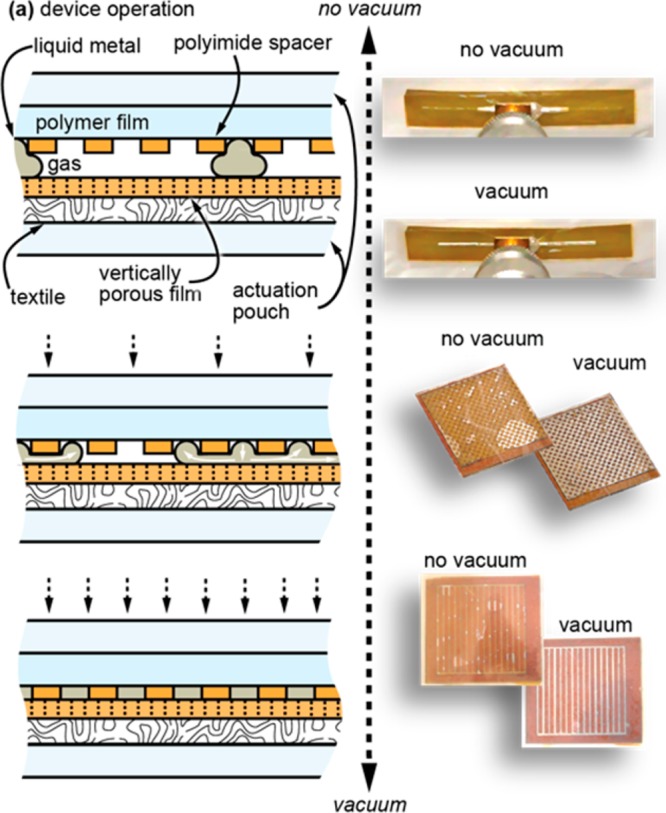
Diagram of a reversible vacuum pressure-actuated liquid metal device in the presence of acid vapor to remove the oxide (left) and photographed examples including antennas, shields, and polarizers (right, top to bottom).
There are opportunities for interfacial scientists to study the complex interplay between the metal, its oxide, and supporting substrates (and surrounding fluids) on the wetting properties of this system of materials. The mechanical properties of the oxide make classic measurements of interfacial properties (e.g., contact angle, pendant drop, sessile drop) difficult to interpret because the fluid cannot always adopt a shape that minimizes interfacial energy. In addition, the oxide skin can break during sample preparation, exposing new metal that can react with air, which results in a dynamic interface.
Finally, our group has recently shown that the surface oxide on EGaIn lowers the interfacial tension of the metal, similar to a surfactant.116 Electrochemical reactions can remove or deposit the oxide and thereby tune the interfacial tension from >500 mN/m to near zero using less than a volt. The ability to tune the interfacial tension so dramatically has only begun to be explored and represents a promising approach for tuning the interfacial behavior of the metal. Figure 13 shows several examples of how the metal changes shape in electrolyte (1 M NaOH) in response to oxidative potentials (∼1 V).
Figure 13.
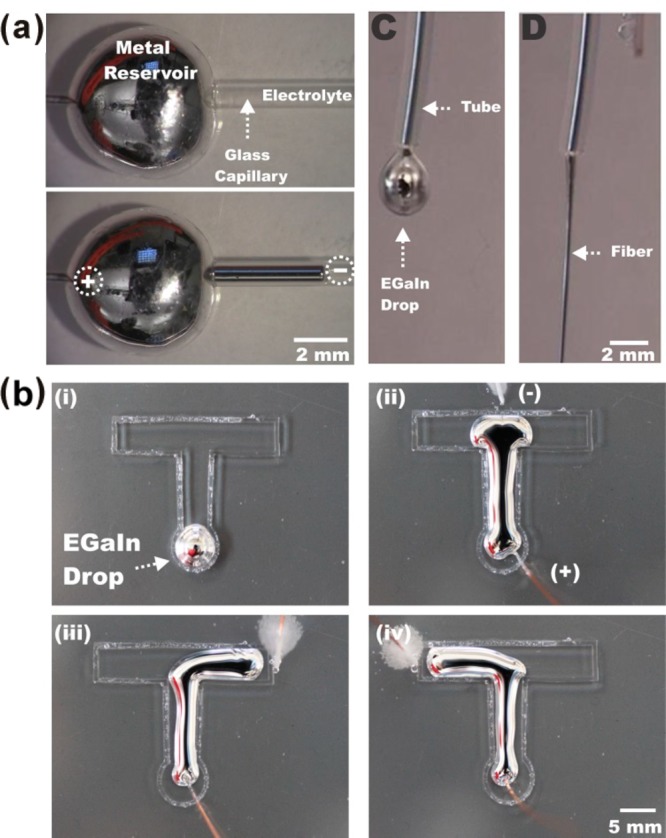
The ability to lower the interfacial tension of the metal under oxidative conditions (∼1 V) in electrolyte provides opportunities to manipulate the shape of the metal. (a) Injection of the metal into a capillary. (b) Controlling the shape of EGaIn in an open channel. (c) Forming a liquid metal wire by pumping the metal out of a tube. Image reproduced with permission from ref (116). Copyright 2014 Proceedings of the National Academy of Science.
Conclusion
This spotlight article focuses on recent applications of liquid metals based on gallium. These metals are interesting because they are liquids with bulk viscosities similar to water, yet can be manipulated into shapes that render them useful for a variety of applications including microfluidics, soft and stretchable electronics, optics, and reconfigurable devices. The metal can be patterned into nonequilibrium shapes because of a thin oxide that forms spontaneously on the surface of the metal. The oxide layer, once considered a nuisance, enables new opportunities for liquid metals and new challenges for interfacial scientists.
Acknowledgments
The author acknowledges support from the NSF (CAREER CMMI-0954321, ERC EEC-1160483, ECCS-0925797, CMMI-1362284, DMR-1121107), the Chancellors Innovation Fund, the Air Force Research Lab, and the efforts of many students and collaborators who contributed to making this perspective possible. In particular, the author thanks Rashed Khan and Collin Eaker for their helpful comments and assistance with figures. Cover graphic by Collin Ladd, Lazar Panich, and Dishit Parekh.
Glossary
Abbreviations
- EGaIn
eutectic gallium indium
The authors declare no competing financial interest.
References
- Giguere P. A.; Lamontagne D. Polarography with a Dropping Gallium Electrode. Science 1954, 120, 390–391. [DOI] [PubMed] [Google Scholar]
- Yun K.-S.; Cho I.-J.; Bu J.-U.; Kim C.-J.; Yoon E. A Surface-Tension Driven Micropump for Low-Voltage and Low-Power Operations. J. Microelectromechanical Syst. 2002, 11, 454–461. [Google Scholar]
- Ni J.; Coldiron S. J.; Zhong C.-J.; Porter M. D. Electrochemically-Actuated Mercury Valve for Flow Rate and Direction Control: Design, Characterization, and Applications. J. Electroanal. Chem. 2001, 504, 166–174. [Google Scholar]
- Jackel J. L.; Hackwood S.; Beni G. Electrowetting Optical Switch. Appl. Phys. Lett. 1982, 40, 4–5. [Google Scholar]
- Shen W.; Edwards R. T.; Kim C.-J. Electrostatically Actuated Metal-Droplet Microswitches Integrated on CMOS Chip. J. Microelectromech. Syst. 2006, 15, 879–889. [Google Scholar]
- Clarkson T. W.; Magos L.; Myers G. J. The Toxicology of Mercury--Current Exposures and Clinical Manifestations. N. Engl. J. Med. 2003, 349, 1731–1737. [DOI] [PubMed] [Google Scholar]
- Spells K. E. Determination of the Viscosity of Liquid Gallium over an Extended Range of Temperature. Proc. Phys. Soc. London 1936, 48, 299–311. [Google Scholar]
- Mott N. F. The Resistance of Liquid Metals. Proc. R. Soc. London, Ser. A 1934, 146, 465–472. [Google Scholar]
- CRC Handbook of Chemistry and Physics, 92nd ed.; CRC Press: Boca Raton, FL, 2011. [Google Scholar]
- Bernstein L. R. Mechanisms of Therapeutic Activity for Gallium. Pharmacol Rev. 1998, 50, 665–682. [PubMed] [Google Scholar]
- Ivanoff C. S.; Ivanoff A. E.; Hottel T. L. Gallium Poisoning: A Rare Case Report. Food Chem. Toxicol. 2012, 50, 212–215. [DOI] [PubMed] [Google Scholar]
- Sheka I. A.; Chaus I. S.; Mitiureva T. T.. The Chemistry of Gallium; Elsevier: New York, 1966. [Google Scholar]
- Briggs L. J. Gallium - Thermal Conductivity - Supercooling - Negative Pressure. J. Chem. Phys. 1957, 26, 784–786. [Google Scholar]
- Popova T. I.; Bagotskaya I. A.; Moorhead E. D.. Encyclopedia of Electrochemistry of the Elements; Marcel Dekker: New York, 1978. [Google Scholar]
- Lous E. J.; Blom P. W. M.; Molenkamp L. W.; de Leeuw D. M. Formation of a Schottky Barrier between Eutectic Ga,In and Thiophene Oligomers. J. Appl. Phys. 1997, 81, 3537–3542. [Google Scholar]
- Du Pasquier A.; Miller S.; Chhowalla M. On the Use of Ga-In Eutectic and Halogen Light Source for Testing P3HT-PCBM Organic Solar Cells. Sol. Energy Mater. Sol. Cells 2006, 90, 1828–1839. [Google Scholar]
- Downs A. J.Chemistry of Aluminium, Gallium, Indium, and Thallium; Blackie Academic & Professional: London, 1993; Vol. 1. [Google Scholar]
- Regan M. J.; Tostmann H.; Pershan P. S.; Magnussen O. M.; DiMasi E.; Ocko B. M.; Deutsch M. X-Ray Study of the Oxidation of Liquid-Gallium Surfaces. Phys. Rev. B Condens. Matter 1997, 55, 10786–10790. [Google Scholar]
- Scharmann F.; Cherkashinin G.; Breternitz V.; Knedlik C.; Hartung G.; Weber T.; Schaefer J. A. Viscosity Effect on GaInSn Studied by XPS. Surf. Interface Anal. 2004, 36, 981–985. [Google Scholar]
- Plech A.; Klemradt U.; Metzger H.; Peisl J. In Situ X-Ray Reflectivity Study of the Oxidation Kinetics of Liquid Gallium and the Liquid Alloy. J. Phys.: Condens. Matter 1998, 10, 971. [Google Scholar]
- Chabala J. M. Oxide-Growth Kinetics and Fractal-like Patterning across Liquid Gallium Surfaces. Phys. Rev. B 1992, 46, 11346–11357. [DOI] [PubMed] [Google Scholar]
- Liu T.; Sen P.; Kim C.-J. Characterization of Nontoxic Liquid-Metal Alloy Galinstan for Applications in Microdevices. J. Microelectromech. Syst. 2012, 21, 443–450. [Google Scholar]
- Dickey M. D.; Chiechi R. C.; Larsen R. J.; Weiss E. A.; Weitz D. A.; Whitesides G. M. Eutectic Gallium-Indium (EGaIn): A Liquid Metal Alloy for the Formation of Stable Structures in Microchannels at Room Temperature. Adv. Funct. Mater. 2008, 18, 1097–1104. [Google Scholar]
- Ladd C.; So J.-H.; Muth J.; Dickey M. D. 3D Printing of Free Standing Liquid Metal Microstructures. Adv. Mater. 2013, 25, 5081–5085. [DOI] [PubMed] [Google Scholar]
- Zrnic D.; Swatik D. S. Resistivity and Surface Tension of the Eutectic Alloy of Gallium and Indium. J. Common Met. 1969, 18, 67–68. [Google Scholar]
- Pourbaix M.Atlas of Electrochemical Equilibria in Aqueous Solutions, second English ed.; National Association of Corrosion Engineers: Houston, TX, 1974; Vol. 16.1. [Google Scholar]
- Xu Q.; Qudalov N.; Guo Q.; Jaeger H.; Brown E.. Effect of Oxidation on the Mechanical Properties of Liquid Gallium and Eutectic Gallium-Indium. arXiv:1201.48282012.
- Larsen R. J.; Dickey M. D.; Whitesides G. M.; Weitz D. A. Viscoelastic Properties of Oxide-Coated Liquid Metals. J. Rheol. 2009, 53, 1305–1326. [Google Scholar]
- Jeyakumar M.; Hamed M.; Shankar S. Rheology of Liquid Metals and Alloys. J. Non-Newton. Fluid Mech. 2011, 166, 831–838. [Google Scholar]
- Wissman J.; Lu T.; Majidi C.. Soft-Matter Electronics with Stencil Lithography. In 2013 IEEE Sensors;Baltimore, MD, Nov 3–6, 2013; IEEE: Piscataway, NJ, 2013; pp 1–4
- Jeong S. H.; Hagman A.; Hjort K.; Jobs M.; Sundqvist J.; Wu Z. Liquid Alloy Printing of Microfluidic Stretchable Electronics. Lab. Chip 2012, 12, 4657–4664. [DOI] [PubMed] [Google Scholar]
- Kramer R. K.; Majidi C.; Wood R. J. Masked Deposition of Gallium-Indium Alloys for Liquid-Embedded Elastomer Conductors. Adv. Funct. Mater. 2013, 23, 5292–5296. [Google Scholar]
- Tabatabai A.; Fassler A.; Usiak C.; Majidi C. Liquid-Phase Gallium–Indium Alloy Electronics with Microcontact Printing. Langmuir 2013, 29, 6194–6200. [DOI] [PubMed] [Google Scholar]
- Gozen B. A.; Tabatabai A.; Ozdoganlar O. B.; Majidi C. High-Density Soft-Matter Electronics with Micron-Scale Line Width. Adv. Mater. 2014, 26, 5211–5216. [DOI] [PubMed] [Google Scholar]
- Zheng Y.; He Z.; Gao Y.; Liu J.. Direct Desktop Printed-Circuits-on-Paper Flexible Electronics. Sci. Rep. 2013, 3. [Google Scholar]
- Yang H.; Lightner C. R.; Dong L. Light-Emitting Coaxial Nanofibers. ACS Nano 2012, 6, 622–628. [DOI] [PubMed] [Google Scholar]
- Fassler A.; Majidi C. 3D Structures of Liquid-Phase GaIn Alloy Embedded in PDMS with Freeze Casting. Lab. Chip 2013, 13, 4442–4450. [DOI] [PubMed] [Google Scholar]
- Zheng Y.; Zhang Q.; Liu J. Pervasive Liquid Metal Based Direct Writing Electronics with Roller-Ball Pen. AIP Adv. 2013, 3, 112117. [Google Scholar]
- Zhang Q.; Zheng Y.; Liu J. Direct Writing of Electronics Based on Alloy and Metal (DREAM) Ink: A Newly Emerging Area and Its Impact on Energy, Environment and Health Sciences. Front. Energy 2012, 6, 311–340. [Google Scholar]
- Boley J. W.; White E. L.; Chiu G. T.-C.; Kramer R. K. Direct Writing of Gallium-Indium Alloy for Stretchable Electronics. Adv. Funct. Mater. 2014, 24, 3501–3507. [Google Scholar]
- Gao Y.; Li H.; Liu J. Direct Writing of Flexible Electronics through Room Temperature Liquid Metal Ink. PLoS One 2012, 7, e45485. [DOI] [PMC free article] [PubMed] [Google Scholar]
- Mohammed M. G.; Dickey M. D. Strain-Controlled Diffraction of Light from Stretchable Liquid Metal Micro-Components. Sens. Actuators Phys. 2013, 193, 246–250. [Google Scholar]
- Ma K.-Q.; Liu J. Nano Liquid-Metal Fluid as Ultimate Coolant. Phys. Lett. A 2007, 361, 252–256. [Google Scholar]
- Vetrovec J.; Litt A. S.; Copeland D. A.; Junghans J.; Durkee R. Liquid Metal Heat Sink for High-Power Laser Diodes. Proc. SPIE 2013, 86050E. [Google Scholar]
- Siegel A. C.; Tang S. K. Y.; Nijhuis C. A.; Hashimoto M.; Phillips S. T.; Dickey M. D.; Whitesides G. M. Cofabrication: A Strategy for Building Multicomponent Microsystems. Acc. Chem. Res. 2010, 43, 518–528. [DOI] [PMC free article] [PubMed] [Google Scholar]
- So J.-H.; Dickey M. D. Inherently Aligned Microfluidic Electrodes Composed of Liquid Metal. Lab Chip 2011, 11, 905–911. [DOI] [PubMed] [Google Scholar]
- Richards A. L.; Dickey M. D.; Kennedy A. S.; Buckner G. D. Design and Demonstration of a Novel Micro-Coulter Counter Utilizing Liquid Metal Electrodes. J. Micromechanics Microengineering 2012, 22, 115012. [Google Scholar]
- Pekas N.; Zhang Q.; Juncker D. Electrostatic Actuator with Liquid Metal–elastomer Compliant Electrodes Used for on-Chip Microvalving. J. Micromechanics Microengineering 2012, 22, 097001. [Google Scholar]
- Hallfors N.; Khan A.; Dickey M. D.; Taylor A. M. Integration of Pre-Aligned Liquid Metal Electrodes for Neural Stimulation within a User-Friendly Microfluidic Platform. Lab. Chip 2013, 13, 522–526. [DOI] [PMC free article] [PubMed] [Google Scholar]
- Gao M.; Gui L. A Handy Liquid Metal Based Electroosmotic Flow Pump. Lab. Chip 2014, 14, 1866–1872. [DOI] [PubMed] [Google Scholar]
- Thelen J.; Dickey M. D.; Ward T. A Study of the Production and Reversible Stability of EGaIn Liquid Metal Microspheres Using Flow Focusing. Lab. Chip 2012, 12, 3961–3967. [DOI] [PubMed] [Google Scholar]
- Hutter T.; Bauer W.-A. C.; Elliott S. R.; Huck W. T. S. Formation of Spherical and Non-Spherical Eutectic Gallium-Indium Liquid-Metal Microdroplets in Microfluidic Channels at Room Temperature. Adv. Funct. Mater. 2012, 22, 2624–2631. [Google Scholar]
- Sivan V.; Tang S.-Y.; O’Mullane A. P.; Petersen P.; Eshtiaghi N.; Kalantar-zadeh K.; Mitchell A. Liquid Metal Marbles. Adv. Funct. Mater. 2013, 23, 144–152. [DOI] [PubMed] [Google Scholar]
- Hohman J. N.; Kim M.; Wadsworth G. A.; Bednar H. R.; Jiang J.; LeThai M. A.; Weiss P. S. Directing Substrate Morphology via Self-Assembly: Ligand-Mediated Scission of Gallium-Indium Microspheres to the Nanoscale. Nano Lett. 2011, 11, 5104–5110. [DOI] [PubMed] [Google Scholar]
- Blaiszik B. J.; Kramer S. L. B.; Grady M. E.; McIlroy D. A.; Moore J. S.; Sottos N. R.; White S. R. Autonomic Restoration of Electrical Conductivity. Adv. Mater. 2012, 24, 398–401. [DOI] [PubMed] [Google Scholar]
- Krupenkin T.; Taylor J. A. Reverse Electrowetting as a New Approach to High-Power Energy Harvesting. Nat. Commun. 2011, 2, 448. [DOI] [PMC free article] [PubMed] [Google Scholar]
- Hong Y.; Ding S.; Wu W.; Hu J.; Voevodin A. A.; Gschwender L.; Snyder E.; Chow L.; Su M. Enhancing Heat Capacity of Colloidal Suspension Using Nanoscale Encapsulated Phase-Change Materials for Heat Transfer. ACS Appl. Mater. Interfaces 2010, 2, 1685–1691. [DOI] [PubMed] [Google Scholar]
- Tang S.-Y.; Khoshmanesh K.; Sivan V.; Petersen P.; O’Mullane A. P.; Abbott D.; Mitchell A.; Kalantar-zadeh K. Liquid Metal Enabled Pump. Proc. Natl. Acad. Sci. U. S. A. 2014, 111, 3304. [DOI] [PMC free article] [PubMed] [Google Scholar]
- Knoblauch M.; Hibberd J. M.; Gray J. C.; van Bel A. J. E. A Galinstan Expansion Femtosyringe for Microinjection of Eukaryotic Organelles and Prokaryotes. Nat. Biotechnol. 1999, 17, 906–909. [DOI] [PubMed] [Google Scholar]
- Tang S.-Y.; Sivan V.; Khoshmanesh K.; O’Mullane A. P.; Tang X.; Gol B.; Eshtiaghi N.; Lieder F.; Petersen P.; Mitchell A.; Kalantar-zadeh K. Electrochemically Induced Actuation of Liquid Metal Marbles. Nanoscale 2013, 5, 5949–5957. [DOI] [PubMed] [Google Scholar]
- Du K.; Glogowski E.; Tuominen M. T.; Emrick T.; Russell T. P.; Dinsmore A. D. Self-Assembly of Gold Nanoparticles on Gallium Droplets: Controlling Charge Transport through Microscopic Devices. Langmuir 2013, 29, 13640–13646. [DOI] [PubMed] [Google Scholar]
- Gu J.; Fahrenkrug E.; Maldonado S. Direct Electrodeposition of Crystalline Silicon at Low Temperatures. J. Am. Chem. Soc. 2013, 135, 1684–1687. [DOI] [PubMed] [Google Scholar]
- Cheng S.; Wu Z. Microfluidic Electronics. Lab. Chip 2012, 12, 2782–2791. [DOI] [PubMed] [Google Scholar]
- Bauer S.; Bauer-Gogonea S.; Graz I.; Kaltenbrunner M.; Keplinger C.; Schwödiauer R. 25th Anniversary Article: A Soft Future: From Robots and Sensor Skin to Energy Harvesters. Adv. Mater. 2013, 26, 149–162. [DOI] [PMC free article] [PubMed] [Google Scholar]
- Hammock M. L.; Chortos A.; Tee B. C.-K.; Tok J. B.-H.; Bao Z. 25th Anniversary Article: The Evolution of Electronic Skin (E-Skin): A Brief History, Design Considerations, and Recent Progress. Adv. Mater. 2013, 25, 5997–6038. [DOI] [PubMed] [Google Scholar]
- Kim D.-H.; Rogers J. A. Stretchable Electronics: Materials Strategies and Devices. Adv. Mater. 2008, 20, 4887–4892. [Google Scholar]
- Weiss E. A.; Chiechi R. C.; Geyer S. M.; Porter V. J.; Bell D. C.; Bawendi M. G.; Whitesides G. M. Size-Dependent Charge Collection in Junctions Containing Single-Size and Multi-Size Arrays of Colloidal CdSe Quantum Dots. J. Am. Chem. Soc. 2008, 130, 74–82. [DOI] [PubMed] [Google Scholar]
- Chiechi R. C.; Weiss E. A.; Dickey M. D.; Whitesides G. M. Eutectic Gallium-Indium (EGaIn): A Moldable Liquid Metal for Electrical Characterization of Self-Assembled Monolayers. Angew. Chem., Int. Ed. 2008, 47, 142–144. [DOI] [PubMed] [Google Scholar]
- Zhang Y.; Zhao Z.; Fracasso D.; Chiechi R. C. Bottom-Up Molecular Tunneling Junctions Formed by Self-Assembly. Isr. J. Chem. 2014, 54, 513–533. [Google Scholar]
- Reus W. F.; Thuo M. M.; Shapiro N. D.; Nijhuis C. A.; Whitesides G. M. The SAM, Not the Electrodes, Dominates Charge Transport in Metal-Monolayer//Ga2O3/Gallium-Indium Eutectic Junctions. ACS Nano 2012, 6, 4806–4822. [DOI] [PubMed] [Google Scholar]
- Nijhuis C. A.; Reus W. F.; Barber J. R.; Dickey M. D.; Whitesides G. M. Charge Transport and Rectification in Arrays of SAM-Based Tunneling Junctions. Nano Lett. 2010, 10, 3611–3619. [DOI] [PubMed] [Google Scholar]
- Lipomi D. J.; Bao Z. Stretchable, Elastic Materials and Devices for Solar Energy Conversion. Energy Environ. Sci. 2011, 4, 3314–3328. [Google Scholar]
- Wang Q.; Niu X.; Pei Q.; Dickey M. D.; Zhao X. Electromechanical Instabilities of Thermoplastics: Theory and in Situ Observation. Appl. Phys. Lett. 2012, 101, 141911–141911 – 4. [DOI] [PMC free article] [PubMed] [Google Scholar]
- Hyun-Joong Kim; Maleki T.; Pinghung Wei; Ziaie B. A Biaxial Stretchable Interconnect With Liquid-Alloy-Covered Joints on Elastomeric Substrate. J. Microelectromech. Syst. 2009, 18, 138–146. [Google Scholar]
- Zhang B.; Dong Q.; Korman C. E.; Li Z.; Zaghloul M. E.. Flexible Packaging of Solid-State Integrated Circuit Chips with Elastomeric Microfluidics. Sci. Rep. 2013, 3. [Google Scholar]
- Baldwin D. F.; Deshmukh R. D.; Hau C. S. Gallium Alloy Interconnects for Flip-Chip Assembly Applications. IEEE Trans. Compon. Packag. Technol. 2000, 23, 360–366. [Google Scholar]
- Park J.; Wang S.; Li M.; Ahn C.; Hyun J. K.; Kim D. S.; Kim D. K.; Rogers J. A.; Huang Y.; Jeon S. Three-Dimensional Nanonetworks for Giant Stretchability in Dielectrics and Conductors. Nat. Commun. 2012, 3, 916. [DOI] [PubMed] [Google Scholar]
- Ponce Wong R. D.; Posner J. D.; Santos V. J. Flexible Microfluidic Normal Force Sensor Skin for Tactile Feedback. Sens. Actuators Phys. 2012, 179, 62–69. [Google Scholar]
- Majidi C.; Kramer R.; Wood R. J. A Non-Differential Elastomer Curvature Sensor for Softer-than-Skin Electronics. Smart Mater. Struct. 2011, 20, 105017. [Google Scholar]
- Park Y.-L.; Majidi C.; Kramer R.; Bérard P.; Wood R. J. Hyperelastic Pressure Sensing with a Liquid-Embedded Elastomer. J. Micromech. Microeng. 2010, 20, 125029. [Google Scholar]
- Park Y.-L.; Chen B.-R.; Wood R. J. Design and Fabrication of Soft Artificial Skin Using Embedded Microchannels and Liquid Conductors. IEEE Sens. J. 2012, 12, 2711–2718. [Google Scholar]
- Lipomi D. J.; Vosgueritchian M.; Tee B. C.-K.; Hellstrom S. L.; Lee J. A.; Fox C. H.; Bao Z. Skin-like Pressure and Strain Sensors Based on Transparent Elastic Films of Carbon Nanotubes. Nat. Nano 2011, 6, 788–792. [DOI] [PubMed] [Google Scholar]
- So J. H.; Thelen J.; Qusba A.; Hayes G. J.; Lazzi G.; Dickey M. D. Reversibly Deformable and Mechanically Tunable Fluidic Antennas. Adv. Funct. Mater. 2009, 19, 3632–3637. [Google Scholar]
- Cheng S.; Rydberg A.; Hjort K.; Wu Z. Liquid Metal Stretchable Unbalanced Loop Antenna. Appl. Phys. Lett. 2009, 94, 144103–144103 – 3. [Google Scholar]
- Kubo M.; Li X.; Kim C.; Hashimoto M.; Wiley B. J.; Ham D.; Whitesides G. M. Stretchable Microfluidic Radiofrequency Antennas. Adv. Mater. 2010, 22, 2749–2752. [DOI] [PubMed] [Google Scholar]
- Cheng S.; Wu Z. Microfluidic Stretchable RF Electronics. Lab. Chip 2010, 10, 3227–3234. [DOI] [PubMed] [Google Scholar]
- Hayes G. J.; So J.-H.; Qusba A.; Dickey M. D.; Lazzi G. Flexible Liquid Metal Alloy (EGaIn) Microstrip Patch Antenna. IEEE Trans. Antennas Propag. 2012, 60, 2151–2156. [Google Scholar]
- Hayes G. J.; Desai S. C.; Liu Y.; Annamaa P.; Lazzi G.; Dickey M. D. Microfluidic Coaxial Transmission Line and Phase Shifter. Microwave Opt. Technol. Lett. 2014, 56, 1459–1462. [Google Scholar]
- Qusba A.; RamRakhyani A. K.; So J.-H.; Hayes G. J.; Dickey M. D.; Lazzi G. On the Design of Microfluidic Implant Coil for Flexible Telemetry System. IEEE Sens. J. 2014, 14, 1074–1080. [Google Scholar]
- Li M.; Yu B.; Behdad N. Liquid-Tunable Frequency Selective Surfaces. IEEE Microwave Wireless Compon. Lett. 2010, 20, 423–425. [Google Scholar]
- Wang J.; Liu S.; Vardeny Z. V.; Nahata A. Liquid Metal-Based Plasmonics. Opt. Express 2012, 20, 2346–2353. [DOI] [PubMed] [Google Scholar]
- Wang J.; Liu S.; Nahata A. Reconfigurable Plasmonic Devices Using Liquid Metals. Opt. Express 2012, 20, 12119–12126. [DOI] [PubMed] [Google Scholar]
- Whitney R. J. The Measurement of Volume Changes in Human Limbs. J. Physiol. 1953, 121, 1–27. [DOI] [PMC free article] [PubMed] [Google Scholar]
- Tepáyotl-Ramírez D.; Lu T.; Park Y.-L.; Majidi C. Collapse of Triangular Channels in a Soft Elastomer. Appl. Phys. Lett. 2013, 102, 044102–044102 – 4. [Google Scholar]
- Kramer R. K.; Majidi C.; Wood R. J.. Wearable Tactile Keypad with Stretchable Artificial Skin. In 2011 IEEE International Conference on Robotics and Automation (ICRA);Shanghai, China, May 9–13, 2011;IEEE: Piscataway, NJ, 2011; pp 1103–1107.
- Kramer R. K.; Majidi C.; Sahai R.; Wood R. J.. Soft Curvature Sensors for Joint Angle Proprioception. In 2011 IEEE/RSJ International Conference on Intelligent Robots and Systems (IROS);San Francisco, Sept 25–30, 2011; IEEE: Piscataway, NJ, 2011; pp 1919–1926.
- Zhu S.; So J.-H.; Mays R.; Desai S.; Barnes W. R.; Pourdeyhimi B.; Dickey M. D. Ultrastretchable Fibers with Metallic Conductivity Using a Liquid Metal Alloy Core. Adv. Funct. Mater. 2013, 23, 2308–2314. [Google Scholar]
- Mineart K. P.; Lin Y.; Desai S. C.; Krishnan A. S.; Spontak R. J.; Dickey M. D. Ultrastretchable, Cyclable and Recyclable 1- and 2-Dimensional Conductors Based on Physically Cross-Linked Thermoplastic Elastomer Gels. Soft Matter 2013, 9, 7695. [Google Scholar]
- Koo H.; So J.; Dickey M. D.; Velev O. D. Towards All-Soft Matter Circuits: Prototypes of Quasi-Liquid Devices with Memristor Characteristics. Adv. Mater. 2011, 23, 3559–3564. [DOI] [PubMed] [Google Scholar]
- So J.; Koo H.; Dickey M. D.; Velev O. D. Ionic Current Rectification in Soft-Matter Diodes with Liquid-Metal Electrodes. Adv. Funct. Mater. 2012, 22, 625–631. [Google Scholar]
- Khan M. R.; Hayes G. J.; So J.-H.; Lazzi G.; Dickey M. D. A Frequency Shifting Liquid Metal Antenna with Pressure Responsiveness. Appl. Phys. Lett. 2011, 99, 013501–013503. [Google Scholar]
- Khan M. R.; Hayes G. J.; Zhang S.; Dickey M. D.; Lazzi G. A Pressure Responsive Fluidic Microstrip Open Stub Resonator Using a Liquid Metal Alloy. IEEE Microwave Wireless Compon. Lett. 2012, 22, 577–579. [Google Scholar]
- Wang J.; Liu S.; Guruswamy S.; Nahata A. Reconfigurable Liquid Metal Based Terahertz Metamaterials via Selective Erasure and Refilling to the Unit Cell Level. Appl. Phys. Lett. 2013, 103, 221116. [Google Scholar]
- Palleau E.; Reece S.; Desai S. C.; Smith M. E.; Dickey M. D. Self-Healing Stretchable Wires for Reconfigurable Circuit Wiring and 3D Microfluidics. Adv. Mater. 2013, 25, 1589–1592. [DOI] [PubMed] [Google Scholar]
- Cordier P.; Tournilhac F.; Soulié-Ziakovic C.; Leibler L. Self-Healing and Thermoreversible Rubber from Supramolecular Assembly. Nature 2008, 451, 977–980. [DOI] [PubMed] [Google Scholar]
- Deshpande R. D.; Li J.; Cheng Y.-T.; Verbrugge M. W. Liquid Metal Alloys as Self-Healing Negative Electrodes for Lithium Ion Batteries. J. Electrochem. Soc. 2011, 158, A845–A849. [Google Scholar]
- Fainman Y.; Lee L.; Psaltis D.; Yang C.; 0071601562; 978–0071601566. Optofluidics: Fundamentals, Devices, and Applications; 1st ed.; McGraw-Hill Professional: New York, 2009. [Google Scholar]
- Butcher T.; Brown T.. Gallium. In Critical Metals Handbook; Gunn G., Ed.; John Wiley & Sons: New York, 2014; pp 150–176. [Google Scholar]
- Dorozhkin P. S.; Tovstonog S. V.; Golberg D.; Zhan J.; Ishikawa Y.; Shiozawa M.; Nakanishi H.; Nakata K.; Bando Y. A Liquid-Ga-Filled Carbon Nanotube: A Miniaturized Temperature Sensor and Electrical Switch. Small 2005, 1, 1088–1093. [DOI] [PubMed] [Google Scholar]
- Gao Y. H.; Bando Y. Carbon Nanothermometer Containing Gallium - Gallium’s Macroscopic Properties Are Retained on a Miniature Scale in This Nanodevice. Nature 2002, 415, 599–599. [DOI] [PubMed] [Google Scholar]
- Gao Y. H.; Bando Y.; Liu Z. W.; Golberg D.; Nakanishi H. Temperature Measurement Using a Gallium-Filled Carbon Nanotube Nanothermometer. Appl. Phys. Lett. 2003, 83, 2913–2915. [Google Scholar]
- Cumby B. L.; Hayes G. J.; Dickey M. D.; Justice R. S.; Tabor C. E.; Heikenfeld J. C. Reconfigurable Liquid Metal Circuits by Laplace Pressure Shaping. Appl. Phys. Lett. 2012, 101, 174102–174102 – 5. [Google Scholar]
- Kim D.; Thissen P.; Viner G.; Lee D.-W.; Choi W.; Chabal Y. J.; Lee J.-B. (J. B. . Recovery of Nonwetting Characteristics by Surface Modification of Gallium-Based Liquid Metal Droplets Using Hydrochloric Acid Vapor. ACS Appl. Mater. Interfaces 2013, 5, 179–185. [DOI] [PubMed] [Google Scholar]
- Doudrick K.; Liu S.; Mutunga E. M.; Klein K. L.; Damle V.; Varanasi K. K.; Rykaczewski K.. Different Shades of Oxide: From Nanoscale Wetting Mechanisms to Contact Printing of Gallium-Based Liquid Metals. Langmuir 2014. [DOI] [PubMed] [Google Scholar]
- Kramer R. K.; Boley J. W.; Stone H. A.; Weaver J. C.; Wood R. J. Effect of Microtextured Surface Topography on the Wetting Behavior of Eutectic Gallium–Indium Alloys. Langmuir 2014, 30, 533–539. [DOI] [PubMed] [Google Scholar]
- Khan M. R.; Eaker C. B.; Bowden E.; Dickey M. D. Proc. Natl. Acad. Sci. U.S.A. 2014, 10.1073/pnas.1412227111. [DOI] [Google Scholar]



